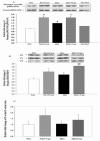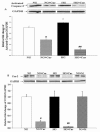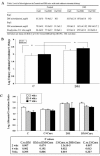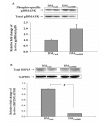Curcumin activates the p38MPAK-HSP25 pathway in vitro but fails to attenuate diabetic nephropathy in DBA2J mice despite urinary clearance documented by HPLC
- PMID: 21073732
- PMCID: PMC2999583
- DOI: 10.1186/1472-6882-10-67
Curcumin activates the p38MPAK-HSP25 pathway in vitro but fails to attenuate diabetic nephropathy in DBA2J mice despite urinary clearance documented by HPLC
Abstract
Background: Curcumin has anti-inflammatory, anti-oxidant, and anti-proliferative properties, and depending upon the experimental circumstances, may be pro- or anti-apoptotic. Many of these biological actions could ameliorate diabetic nephropathy.
Methods/design: Mouse podocytes, cultured in basal or high glucose conditions, underwent acute exposure to curcumin. Western blots for p38-MAPK, COX-2 and cleaved caspase-3; isoelectric focusing for HSP25 phosphorylation; and DNase I assays for F- to G- actin cleavage were performed for in vitro analyses. In vivo studies examined the effects of dietary curcumin on the development of diabetic nephropathy in streptozotocin (Stz)-induced diabetes in DBA2J mice. Urinary albumin to creatinine ratios were obtained, high performance liquid chromatography was performed for urinary curcuminoid measurements, and Western blots for p38-MAPK and total HSP25 were performed.
Results: Curcumin enhanced the phosphorylation of both p38MAPK and downstream HSP25; inhibited COX-2; induced a trend towards attenuation of F- to G-actin cleavage; and dramatically inhibited the activation of caspase-3 in vitro. In curcumin-treated DBA2J mice with Stz-diabetes, HPLC measurements confirmed the presence of urinary curcuminoid. Nevertheless, dietary provision of curcumin either before or after the induction of diabetes failed to attenuate albuminuria.
Conclusions: Apart from species, strain, early differences in glycemic control, and/or dosing effects, the failure to modulate albuminuria may have been due to a decrement in renal HSP25 or stimulation of the 12/15 lipoxygenase pathway in DBA2J mice fed curcumin. In addition, these studies suggest that timed urine collections may be useful for monitoring curcumin dosing and renal pharmacodynamic effects.
Figures







Similar articles
-
Glucose and diabetes: effects on podocyte and glomerular p38MAPK, heat shock protein 25, and actin cytoskeleton.Kidney Int. 2006 Mar;69(5):806-14. doi: 10.1038/sj.ki.5000033. Kidney Int. 2006. PMID: 16421517
-
Interplay between Akt and p38 MAPK pathways in the regulation of renal tubular cell apoptosis associated with diabetic nephropathy.Am J Physiol Renal Physiol. 2010 Jan;298(1):F49-61. doi: 10.1152/ajprenal.00032.2009. Epub 2009 Sep 2. Am J Physiol Renal Physiol. 2010. PMID: 19726550 Free PMC article.
-
Inhibition of high glucose-induced inflammation and fibrosis by a novel curcumin derivative prevents renal and heart injury in diabetic mice.Toxicol Lett. 2017 Aug 15;278:48-58. doi: 10.1016/j.toxlet.2017.07.212. Epub 2017 Jul 9. Toxicol Lett. 2017. PMID: 28700904
-
An examination of the protective effects and molecular mechanisms of curcumin, a polyphenol curcuminoid in diabetic nephropathy.Biomed Pharmacother. 2022 Sep;153:113438. doi: 10.1016/j.biopha.2022.113438. Epub 2022 Aug 1. Biomed Pharmacother. 2022. PMID: 36076553 Review.
-
Repurposing Nano Curcumin: Unveiling its Therapeutic Potential in Diabetic Nephropathy.Curr Drug Targets. 2025;26(5):298-319. doi: 10.2174/0113894501326054241126043554. Curr Drug Targets. 2025. PMID: 39779572 Review.
Cited by
-
Histone Acetylation and Its Modifiers in the Pathogenesis of Diabetic Nephropathy.J Diabetes Res. 2016;2016:4065382. doi: 10.1155/2016/4065382. Epub 2016 Jun 9. J Diabetes Res. 2016. PMID: 27379253 Free PMC article. Review.
-
The Role of EGFR/ERK/ELK-1 MAP Kinase Pathway in the Underlying Damage to Diabetic Rat Skin.Indian J Dermatol. 2013 Mar;58(2):101-6. doi: 10.4103/0019-5154.108035. Indian J Dermatol. 2013. PMID: 23716797 Free PMC article.
-
Selected Indonesian Medicinal Plants for the Management of Metabolic Syndrome: Molecular Basis and Recent Studies.Front Cardiovasc Med. 2020 May 6;7:82. doi: 10.3389/fcvm.2020.00082. eCollection 2020. Front Cardiovasc Med. 2020. PMID: 32435657 Free PMC article. Review.
-
Role of Epigenetic Histone Modifications in Diabetic Kidney Disease Involving Renal Fibrosis.J Diabetes Res. 2017;2017:7242384. doi: 10.1155/2017/7242384. Epub 2017 Jun 13. J Diabetes Res. 2017. PMID: 28695133 Free PMC article. Review.
-
Curcumin and diabetes: a systematic review.Evid Based Complement Alternat Med. 2013;2013:636053. doi: 10.1155/2013/636053. Epub 2013 Nov 24. Evid Based Complement Alternat Med. 2013. PMID: 24348712 Free PMC article. Review.
References
Publication types
MeSH terms
Substances
Grants and funding
LinkOut - more resources
Full Text Sources
Medical
Research Materials

